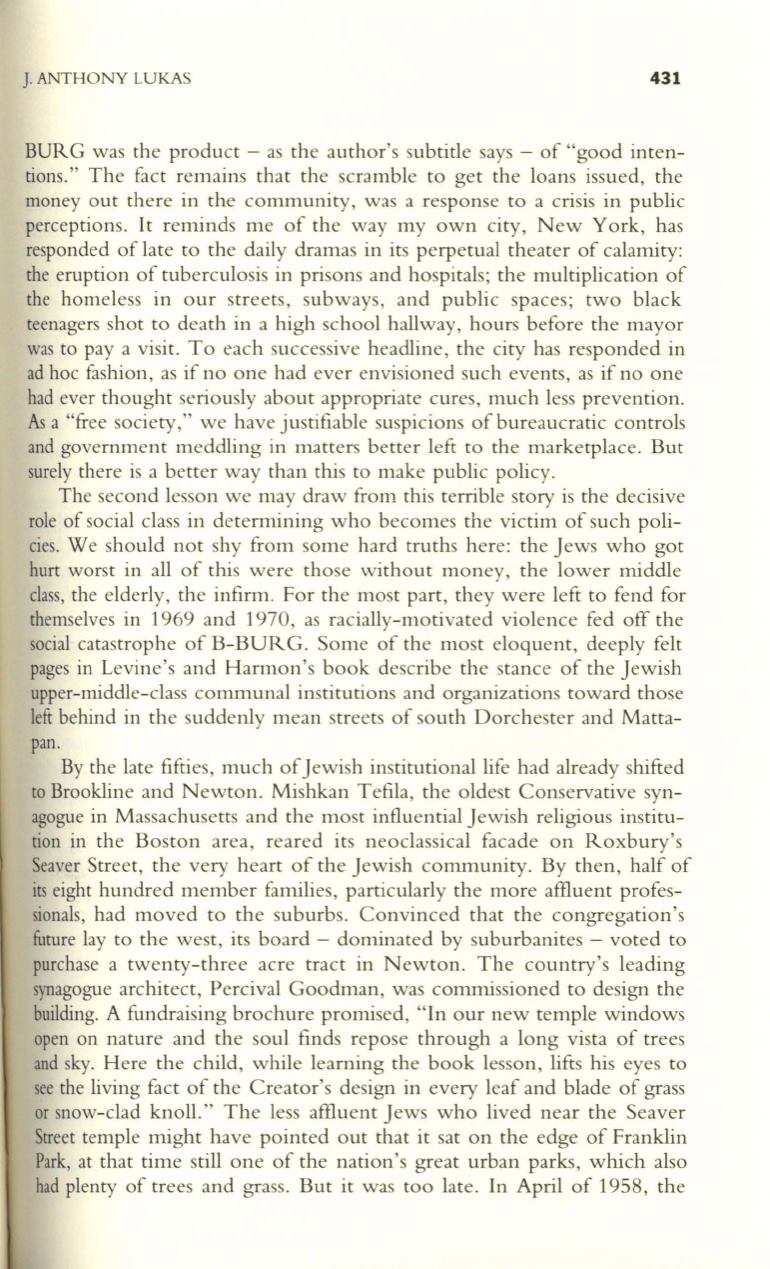
J.
ANTHONY LUKAS
431
BURG was the product - as the author's subtitle says - of "good inten–
tions." The fact remains that the scramble to get the loans issued, the
money out there in the community, was a response to a crisis in public
perceptions. It reminds me of the way my own city, New York, has
responded of late to the daily dramas in its perpetual theater of calamity:
the eruption of tuberculosis in prisons and hospitals; the multiplication of
the homeless in our streets, subways, and public spaces; two black
teenagers shot to death in a high school hallway, hours before the mayor
was to pay a visit. To each successive headline, the city has responded in
ad hoc fashion, as if no one had ever envisioned such events, as if no one
had ever thought seriously about appropriate cures, much less prevention.
As a "free society," we have justifiable suspicions of bureaucratic controls
and government meddling in matters better left to the marketplace. But
surely there is a better way than this to make public policy.
The second lesson we may draw from this terrible story is the decisive
role of social class in determining who becomes the victim of such poli–
cies. We should not shy from some hard truths here: the Jews who got
hurt worst in all of this were those without money, the lower middle
class, the elderly, the infirm. For the most part, they were left to fend for
themselves in 1969 and 1970, as racially-motivated violence fed off the
social catastrophe of B-BURG. Some of the most eloquent, deeply felt
pages in Levine's and Harmon's book describe the stance of the Jewish
upper-middle-class communal institutions and organizations toward those
left behind in the suddenly mean streets of south Dorchester and Matta–
pan.
By the late fifties, much ofJewish institutional life had already shifted
to Brookline and Newton. Mishkan Tefila, the oldest Conservative syn–
agogue in Massachusetts and the most influential Jewish religious institu–
tion in the Boston area, reared its neoclassical facade on Roxbury's
Seaver Street, the very heart of the Jewish community. By then, half of
its eight hundred member families, particularly the more affiuent profes–
sionals, had moved to the suburbs. Convinced that the congregation's
future lay to the west, its board - dominated by suburbanites - voted to
purchase a twenty-three acre tract in Newton. The country's leading
synagogue architect, Percival Goodman, was commissioned to design the
building. A fundraising brochure promised, "In our new temple windows
open on nature and the soul finds repose through a long vista of trees
and sky. Here the child, while learning the book lesson, lifts his eyes to
see the living fact of the Creator's design in every leaf and blade of grass
or snow-clad knoll." The less affiuent Jews who lived near the Seaver
Street temple might have pointed out that it sat on the edge of Franklin
Park, at that time still one of the nation's great urban parks, which also
had plenty of trees and grass. But it was too late. In April of 1958, the


